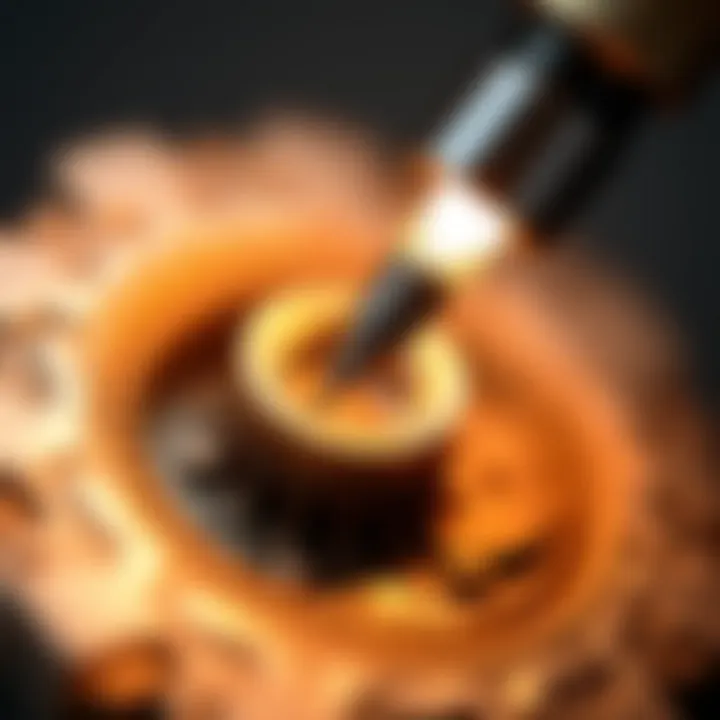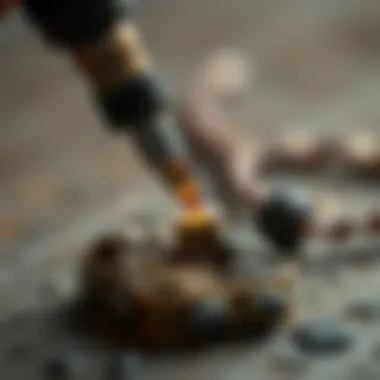Harnessing Micro Torches for Precision Jewelry Crafting


Intro
Jewelry making is an art form that melds creativity with precise techniques. Within this intricate craft, micro torches have emerged as vital tools, empowering artisans and enthusiasts alike to manipulate metal with finesse. While some might think a small flame can’t do much, these compact marvels wield substantial power in the hands of those who know how to use them. Startling as it may seem, the world of micro torches offers significantly more than just heat; it encapsulates a variety of applications that enhance the jewelry making process.
Micro torches come to the forefront with their ability to provide focused heat for intricate tasks like soldering, melting, and engraving. When it comes to crafting quality pieces, being precise isn’t just a bonus; it's a requirement. This article will unpack not only the different types of micro torches available but will also lend insight into best practices, safety precautions, and maintenance tips.
As we delve into the essence of micro torches, we’ll better understand their historical significance and evolution, shedding light on how they have transformed the landscape of jewelry making.
"The flame is the artist’s brush, and the metal is the canvas."
Ready your workspace as we embark on this exploration into the world of micro torches and their pivotal role in jewelry making.
Prologue to Micro Torches
Micro torches have transformed the landscape of jewelry making, providing artists ranging from hobbyists to seasoned professionals with tools that are not just versatile but essential. For those engaged in the intricate art of crafting jewelry, the precision and control offered by these devices can significantly enhance the quality and detail of the work produced. Without a doubt, understanding micro torches is foundational to mastering techniques that allow for creative expression and technical skill in this field.
Defining Micro Torches
Micro torches are compact, portable devices designed for producing a concentrated flame suitable for tasks such as soldering, enameling, and metal texturing. They often use butane or propane as fuel and can reach high temperatures, which makes them incredibly effective for various jewelry-making tasks. These torches can be exceptionally fine-tuned, allowing the jeweler to direct heat precisely where it's needed, minimizing the risk of overheating adjacent areas. This characteristic makes micro torches an indispensable tool in achieving delicate work that larger torches cannot accomplish effectively.
History and Evolution
Tracing the evolution of micro torches reveals a fascinating journey from rudimentary flame sources to the sophisticated tools we see today. Historically, jewelers managed with basic tools, often adapting items like candle flames for their heating needs. As the demand for more precise equipment grew, innovations followed suit. During the late 20th century, the advent of gas technology gave rise to the modern forms of micro torches, revolutionizing jewelry making.
In recent years, advancements have focused on ergonomics and efficiency. With features like adjustable flame sizes, improved safety features, and easy refueling, micro torches have become accessible not only to professionals but also to enthusiasts eager to explore metalworking. Today, they represent a perfect blend of tradition and technology, helping artists realize their visions with unparalleled precision.
The Importance of Micro Torches in Jewelry Making
Micro torches are more than just tools; they are essential companions for jewelry makers who strive for precision and creativity. Their significance is grounded in the advantages they offer in various aspects of the crafting process, making them irreplaceable in modern-day jewelry making. This section delves into the core elements that highlight their importance, examining how micro torches enhance the artistry and technical prowess required in this field.
Precision and Control in Work
One of the most distinguishing features of micro torches is the degree of precision they offer. When working on delicate pieces, details make all the difference, and the ability to control flame size and intensity cannot be overstated. For instance, when soldering tiny components on intricate settings, a micro torch allows jewelers to focus the heat exactly where it’s needed, minimizing the risk of damaging surrounding materials. This control is particularly advantageous when dealing with heat-sensitive gems or thin metal sheets, where excessive heat can lead to irreversible loss.
Moreover, adjusting the flame characteristics can enhance not only the solder joints but also affect other aspects of the jewelry piece, such as texture or finish. Jewelers can create different effects, like subtle gradients or bold contrasts, just by manipulating the flame, leading to unique and personalized creations. Precision doesn’t merely equate to accuracy; it envelopes the artistry within the intricacies of each design.
Versatility of Application
Micro torches shine in their versatility, serving a myriad of applications beyond just soldering. They can be wielded for enameling, allowing artisans to fuse powdered glass directly onto metal for colorful designs. This technique requires heat control to ensure that the enamel adheres correctly without bubbling, emphasizing yet again the tool's importance in the creative process.
Furthermore, micro torches can be used for:
- Metal Texturing: They can create textures that add depth and dimension to pieces, transforming flat metal into works of art.
- Melt and Shape Jewelry Components: Jewelers can melt metals to create unique forms or even recycle scraps efficiently.
- Brazing: This application is essential when joining metals of different types, requiring adjusted temperatures to ensure proper bonding without compromising the integrity of the materials involved.
The endless adaptability of micro torches allows artists to explore, innovate, and craft with confidence. Every jeweler, whether a novice or a seasoned professional, can look at their torch not just as a tool, but as a gateway to creativity and exploration. The importance of micro torches in jewelry making clearly reflects in their ability to equip artisans with skills that elevate their craftsmanship to new heights.
Key Features of Micro Torches
When delving into the realm of jewelry making, understanding the key features of micro torches is essential for both novice and experienced artisans. These tools are not just about producing heat; they encompass a range of elements that contribute to their effectiveness in intricate metalworking. From flame characteristics to fuel types, each feature plays a pivotal role in how jewelers employ these torches in their creations. This section will explore critical aspects such as flame characteristics and fuel types, offering insights into why they matter deeply in jewelry making.
Flame Characteristics
Temperature Range
The temperature range of a micro torch determines the types of materials it can work with, making it a fundamental aspect for jewelers to consider. Most micro torches can reach temperatures between 1,300°C to 1,700°C (2,372°F to 3,092°F), which is ideal for melting and soldering various metals such as silver and gold.
One of the key characteristics of an optimal temperature range is its ability to offer precision. Jewelers may need to work on delicate components, where overheating can lead to deformation or damage. A torch that allows users to adjust the temperature provides flexibility, catering to the specific demands of different projects. This controllability ensures that artisans can fire enamels without burning through to the underlying metal, a detail that speaks volumes in quality craftsmanship.
However, the downside regarding temperature range lies in the requirement for expertise. If a user miscalculates the temperature, they might face unintended consequences, such as unwanted oxidation or even melting materials they aimed to join. Therefore, while a wide temperature range provides versatility, the users' understanding and experience with that range remain crucial.
Flame Size and Shape
Flame size and shape contribute independently to the micro torch's effectiveness, impacting how heat is applied to specific areas of a jewelry piece. A larger flame may be advantageous when working on bigger surfaces, but a focused, smaller flame is often necessary for intricate detail work. The adjustability of flame size can significantly influence both precision and control.
A key advantage of customizable flame shapes, such as a pinpoint or broad flame, is the targeted heat application. For instance, a finer point is exceptional for delicate soldering, ensuring that surrounding areas remain untouched. Moreover, a broader flame can cover greater surface areas, easing the process in simpler tasks such as fusing.
Nonetheless, jewelers must beware; using the wrong flame shape for a particular task can lead to a lack of control. Wider flames can inadvertently spread heat to adjacent parts, potentially leading to problems that compromise the integrity of the overall design. The challenges present with flame size and shape reinforce why selecting the right torch is critical as the ability to shape flame can directly impact the quality of the work.
Fuel Types


Propane vs. Butane
When it comes to fueling micro torches, the stand-off between propane and butane is significant. Propane is often favored for more intense operations owing to its higher heat output, which can be beneficial for tasks like metal brazing and jewelry fabrication. It's also available in larger gas tanks that last longer, reducing the need for frequent refueling interruptions during work.
On the flip side, butane torches, known for their portability, produce a cleaner burn with less soot, making them ideal for detailed tasks and settings where aesthetics are paramount. Jewelers often prefer these aspects, especially when working with delicate pieces, as they minimize residue that could mar a finished surface.
However, high temperatures from propane can also cause more oxidation, which can be a concern in quality jewelry making. Therefore, understanding the balance between heat output and the specific project requirements is vital for success.
Availability and Cost
The availability and cost of fuel types can also dictate a jeweler's choice in micro torches. Generally, propane is widely accessible and reasonably priced in local hardware stores. This makes it favorable for jewelers who frequently perform projects requiring high temperatures. Moreover, the cost-effectiveness of propane refills can be appealing, especially for studios that operate on a larger scale.
Conversely, while butane can also be found in various outlets, it sometimes commands a higher price. Its high-end sales in specialty shops might not always be the most user-friendly option in terms of operational cost overall. Nevertheless, many artists consider investing in butane as it delivers cleaner results, and fewer cleaning preparations is a conscious trade-off for a higher purchase price.
In summary, becoming fluent in the characteristics of flames and fuel types helps jewelers make informed choices that can directly enhance their craft. Understanding these nuances fosters not just effective craftsmanship but also a refined approach to using micro torches.
Applications of Micro Torches in Jewelry Making
The use of micro torches in jewelry making is an indispensable aspect for both amateurs and seasoned artisans alike. These torches are not just tools; they embody a blend of science and artistry that unlocks a treasure trove of possibilities in creating intricate designs. From soldering to enameling, their precise applications significantly elevate the quality and craftsmanship of the finished pieces.
Soldering Techniques
Types of Solder
When it comes to soldering, the choice of solder is crucial. There are various types including hard, medium, and easy solders, which cater to different needs in jewelry making. Hard solder, for example, is known for its robust strength and is often used for pieces that carry a lot of weight or stress.
The medium solder offers a balance, being easier to work with and providing decent strength at lower temperatures. Meanwhile, easy solder melts at lower temperatures, making it ideal for delicate projects where overheating could potentially ruin precious details. Each type has its unique characteristics and contributes to the overall success of a project, allowing jewelers to choose one that aligns with their specific requirements.
Process Description
The process of soldering involves several steps that meld chemistry and artistry. Typically, a jeweler starts by cleaning the metal surfaces, ensuring they are free from oxidation, which could hamper adhesion. Following that, a flux is applied to protect the metal and facilitate the flow of solder. Once everything is in place, the micro torch shoots out a focused flame, heating the area until the solder melts and fills in any gaps.
This technique offers several advantages like precise control over the flame, which is essential for detailed work. Jewelers can manipulate the flame size, directing heat exactly where it’s needed. However, potential challenges arise if the temperature is not managed appropriately, leading to either insufficient melting or, conversely, damage to the item.
Enameling Processes
Enameling is another intriguing application of micro torches in jewelry making. This technique involves fusing powdered glass onto metal surfaces, creating vibrant colors and textures that transform the pieces into true works of art. Using a torch instead of a kiln grants artisans the ability to focus heat with pinpoint accuracy, making it easier to work with fine details or fragile designs.
The main advantage here is the control offered; one can repeatedly apply heat to achieve the desired finish without compromising the integrity of the underlying metal. Additionally, various types of enamel can be layered to create depth and intricate patterns. However, this process requires a delicate hand and a good understanding of the materials to avoid unsatisfactory results.
Metal Texturing and Finishing
Last but not least, micro torches are an excellent tool for metal texturing and finishing. By varying the flame or using different techniques, jewelers can achieve a range of textures from smooth to rugged finishes. This not only enhances the aesthetic appeal but also strengthens the metal through the annealing process, which softens it for further manipulation.
Techniques like reticulation involve heating the metal until certain layers expand and create a textured surface. Additionally, some jewelers employ the torch to produce a matte finish or to highlight the contrasts in different metals. The versatility offered by micro torches in these methods gives designers an edge in creating unique, standout pieces that capture attention.
"Micro torches are not just tools; they are gateways to creativity for jewelers, opening up myriad possibilities in design and technique."
In summary, the applications of micro torches in jewelry making extend far beyond basic functionality. They embody a critical intersection of precision and creativity, allowing artisans to explore different techniques from soldering to enameling, and even complex metal finishing methods. This pivotal role enhances not just the processes involved but ultimately the artistry of the final products as well.
Safety Considerations
Safety is paramount when it comes to jewelry making with micro torches. These tools, while immensely useful, come with risks that must be carefully managed. Proper safety measures enhance the creative process by allowing jewelers to work confidently and with focus. Taking safety precautions not only protects the individual but also safeguards the workspace, preserving both the tools and the materials used.
Protective Gear
Proper Clothing
When handling a micro torch, selecting the right clothing is crucial. Wearing flame-resistant attire can significantly reduce risks associated with potential burns or injuries from accidental flame exposure. Long sleeves made from natural fibers, such as cotton, typically serve as a good choice in this context. This material is breathable and minimizes the risk of igniting if exposed to heat. Avoiding synthetic fabrics is essential, as these can melt upon contact with flames, causing severe skin damage.
A key characteristic of proper clothing is its ability to offer coverage while allowing flexibility and ease of movement. Jewelers often need to maneuver their arms and hands freely while working, so finding a balance between protection and comfort is important. Moreover, wearing an apron helps to shield the torso and can even have pockets for tools.
While no garment can guarantee safety, choosing flame-resistant clothing is a wise move that adds an extra layer of protection.
Eye Protection
Protecting one’s eyes is non-negotiable when using micro torches. The intense light generated can be harmful, potentially damaging vision with prolonged exposure. Safety goggles or specialized eyewear designed for such tasks are recommended. A notable advantage of these goggles is their ability to block harmful radiation as well as the risk from flying debris during creative processes like soldering.
It’s wise to look for goggles that provide a snug fit, ensuring there’s no way for solder spatter or heat to penetrate. Also, considering lenses with anti-fog properties can improve visibility during intense sessions. Many jewelers favor goggles that combine durability with comfort since they may be worn for long periods, especially during complex projects.
Work Environment Safety
Ventilation Needs
Proper ventilation is critical when working with micro torches, as fumes and excess heat can accumulate quickly. An adequately ventilated space provides fresh air circulation, helping to disperse hazardous gases that may be released during the soldering process. Keeping windows open, using exhaust fans or setting up a fume hood can enhance safety in the workspace. These measures not only protect health but also aid in maintaining an optimal environment for creativity. A significant characteristic of effective ventilation is its ability to mitigate risks associated with inhaling toxic fumes. Jewelers should aim for a space where air flows freely to minimize health risks. Inadequate ventilation can lead to headaches, dizziness, or more serious health issues over time.


Fire Safety Measures
Implementing fire safety measures in a workspace where micro torches are used is vital. Having a fire extinguisher, rated for flammable liquids and gases, is an excellent start. Additionally, it's wise to be familiar with what type of fire extinguisher suits the materials you work with. A common choice among jewelers is a class B extinguisher, effective against LPG fires.
Another important aspect is to test smoke detectors regularly to ensure they are in working order. Keeping a clear and organized workspace, free from clutter, further minimizes the chances of an accidental fire.
The unique feature of having strong fire safety measures is that they create a sense of security. While creativity thrives on exploration, knowing that your workspace is equipped with the right tools for safety allows you to focus on crafting your art, rather than worrying about potential accidents.
"Safety is not just a priority, but a responsibility in every creative endeavor."
Choosing the Right Micro Torch
Selecting the right micro torch is pivotal for anyone delving into the intricate world of jewelry making. Without a dependable torch, you might find yourself in a pinch during critical moments, especially when precision is required. The ideal torch not only enhances your craftsmanship but also elevates safety, efficiency, and overall output quality. Making an informed choice hinges on understanding various factors, such as brand reliability and pricing structures, which can ultimately shape your jewelry-making experience.
Brand Comparisons
When it comes to picking a micro torch, considering the brand can be a game-changer. Different manufacturers tend to feature unique technologies and design philosophies, and that can influence your work significantly. Here are a few brands that are noteworthy:
- Blazer: Known for their professional-grade torches, they offer features like adjustable flame sizes and ergonomic designs. They're often the go-to for serious jewelers.
- Stingray: While they might not be as mainstream, Stingray products are crafted with a focus on durability and ease of use, making them great for hobbyists or those new to the craft.
- Bernzomatic: Often found in hardware stores, their micro torches promise reliability and affordability but may lack the precision features that professionals prefer.
As you weigh these options, think about your specific needs. Are you looking for consistent heat output for soldering? Or do you need something lightweight for portability? Each brand has its strengths, so assess them based on your typical projects.
Price Considerations
Price is another beast altogether when it comes to selecting a micro torch. Just because a torch comes with a hefty price tag doesn’t mean it’s the right one for you.
- Entry-Level Torches: These usually range from $25 to $50 and are suitable for beginners or light use. They get the job done but may not stand the test of time or rigorous applications.
- Mid-Range Torches: Priced between $51 and $150, these often strike a balance between quality and affordability. This is where you’ll find many of the reputable names offering torches with versatile features.
- High-End Options: Expect to pay above $150 for these. These are geared toward seasoned professionals who need high performance, consistency, and specialized features.
Remember, your budget should align with your intentions for the micro torch. If you're simply exploring jewelry making as a hobby, a smaller investment might be all you need. However, if you're committed to crafting intricate pieces regularly, splurging on a higher-end model could very well pay off in the long run.
Choosing the right micro torch significantly impacts your jewelry-making journey. By weighing the strengths of different brands and considering your price range, you’ll set the stage for successful and precise crafting.
Maintenance and Care of Micro Torches
The care and upkeep of your micro torch can significantly affect its performance and longevity. Just like any tool, a little attention to detail goes a long way. A well-maintained micro torch not only ensures safety during use but also enhances overall efficiency in jewelry making. Regular cleaning and proper storage are essential practices that can save you from inconvenient breakdowns or even hazardous situations while working on your intricate pieces.
Cleaning Procedures
Cleaning your micro torch should become a part of your routine after each major use. Residues from fuel, soot, or any metal particulates can accumulate over time and lead to inconsistent flame or even operational failures. Here are the key steps to effectively clean your micro torch:
- Turn Off and Cool Down: Always ensure that the torch is completely off and has cooled to avoid burns or injuries.
- Disassemble if Possible: Some models allow for easy disassembly. Check the manufacturer’s instructions on how to take apart the different components safely.
- Wipe Down Surfaces: Use a soft cloth dampened with a mild cleaner to wipe the exterior. Do not immerse the torch in water.
- Check the Nozzle: The nozzle is crucial for achieving a precise flame. Ensure it's unobstructed by cleaning gently with a soft brush.
- Fuel Chamber Maintenance: Occasionally refill your torch based on usage, but avoid overfilling. Leftover fuel can create a residue that’s hard to clean.
By adhering to these cleaning protocols, you can maintain a fire that burns bright, allowing for intricate soldering or texturing tasks without disruption.
Storage Tips
When it comes to storing your micro torch, it’s about creating the right environment for longevity. Here’s how you can do it:
- Keep in a Cool, Dry Place: Store your torch away from heat sources and direct sunlight. Extreme temperatures can affect the fuel and functionality.
- Utilize a Case: If available, place your torch in a protective case. This not only guards against physical damage but also prevents dust from settling in critical areas.
- Store Upright: Always keep the torch upright to avoid any potential leaks from the fuel chamber. This also helps maintain the integrity of internal components.
- Check Regularly: Make it a habit to inspect your stored torch. Look out for any signs of wear or any issues that need addressing before the next use.
Proper storage ensures that the torch remains in tip-top shape, ready for when inspiration strikes.
"A little care goes a long way; investing time in maintaining your tools reflects in the quality of your work."
By following these maintenance and care tips, jewelers can minimize the risk of malfunctions while maximizing creativity in their projects. Remember to make these practices a habit for a seamless experience in your jewelry-making journey.
Mastering Techniques with Micro Torches
Mastering techniques with micro torches is pivotal for any jewelry maker—be they hobbyists or seasoned professionals. This mastery is not just about wielding a tool; it's about elevating the craft. With precision torches, every bead, wire, and gemstone becomes an extension of the artist’s vision. The right technique can take a simple piece of metal and transform it into a captivating work of art.
When it comes to micro torches, the learning curve can be steep, but the rewards are plentiful. Understanding proper flame control, mastering heat applications, and familiarizing oneself with the diverse materials at play—these are the essentials for a jeweler aiming to create with perfection and flair.
Considerations in Mastering Techniques:
- Experimentation is Key: Don't shy away from trial and error. Playing with techniques can lead to unexpected brilliance.
- Continuous Learning: Stay updated with advancements in torch technologies and methods. Join workshops and connect with other artisans for shared knowledge.
- Bonding with Equipment: Understand the nuances of your torch; every model has its quirks, and knowing them can save a world of woe during intricate tasks.
"In the hands of the skilled, a micro torch is not just a tool; it’s a magic wand that breathes life into raw materials."
Essential Techniques for Beginners
For those new to the world of micro torches, beginning with foundational techniques is vital. Here are some techniques that can help novices build confidence and skill:
- Basic Flame Control: Start by understanding how to adjust the flame size and shape. A larger flame is suitable for broader areas while a smaller, more precise flame helps when working on delicate details.
- Simple Soldering: Master the basics of soldering first. This includes selecting appropriate solder types and practicing on scrap pieces of metal to get a feel for how the torch interacts with different materials.
- Heat Management: Learning how different metals heat up and cool down will enhance your work. It’s crucial to know when to apply heat slowly and when a quick burst is required.
- Practice with Enamel: Starting with enamel can be a good introduction. It teaches the importance of temperature and timing, and how to manipulate heat for different finishes.


Advanced Techniques for Experienced Jewelers
Once basic proficiency is attained, seasoned jewelers can dive into more complex techniques that elevate their craft.
- Precision Soldering: Advanced jewelers often work with multiple pieces that must be soldered together precisely. Techniques like tack soldering allow for temporary bonds while final adjustments are made.
- Metal Melding: Understanding how to meld unique metal types, like combining gold and sterling silver, requires finesse and a keen sense of flame control. Each metal behaves differently under heat, making this a crucial skill.
- Patterning Technique: Using the torch to create unique textures or patterns on metals opens up design possibilities. Techniques such as reticulation can create stunning visual effects.
- Multi-Material Projects: Incorporating various materials, such as incorporating glass or stones, demands an understanding of their unique requirements for heat. Techniques around securing these materials safely can lead to innovative jewelry designs.
By embracing both fundamental techniques and refining advanced methods, jewelers not only enhance their skills but also expand their creative horizons. The journey in mastering micro torch techniques is as intricate as the jewelry crafted through their use.
Common Mistakes to Avoid
Making jewelry with micro torches can be an incredibly rewarding endeavor. However, with any craft, it's easy to step in it if you’re not careful. Learning about common mistakes is vital to not only improving your skills but also avoiding costly mishaps. This section covers some typical pitfalls that can trip up both novices and seasoned jewelers alike.
Overheating Metal
One of the most common blunders when utilizing micro torches is overheating the metal you’re working with. The flame is intense and can lead you down a slippery slope of mistakes if not controlled properly. When metal overheats, it loses its desired properties; this can cause warping, melting, or creating defects in the finished piece.
Here are some suggestions to avoid overheating your metal:
- Control the Distance: Keep the flame at an appropriate distance from the workpiece. If the torch is too close, the metal can turn to liquid in the blink of an eye, leading to losses in both material and time.
- Use a Heat Sink: A heat sink can absorb excess heat, helping to regulate the temperature of your metal. This is particularly useful for delicate pieces where even a minute change in temperature can lead to catastrophic results.
- Practice Flame Management: Understanding the flame characteristics of your micro torch is crucial. Practice adjusting the flame size and intensity before working on your actual project. Familiarity with your tools helps in obtaining better control and ultimately leads to higher quality work.
"A gentle touch yields the finest results, not a wild flame."
Ignoring Safety Protocols
No matter your experience level, safety should never be an afterthought when working with fire and combustibles. Ignoring safety protocols can lead to serious accidents, not just for yourself but also for anyone in the vicinity.
Here are several safety measures to keep in mind:
- Protective Gear: Always wear safety goggles, heat-resistant gloves, and an apron to protect yourself from accidental burns. This gear is your first line of defense, so never skip it.
- Adequate Ventilation: Make sure your workspace is well-ventilated. Working with a micro torch produces fumes, and inhaling these can be detrimental to your health. If you can, work outdoors or in a well-ventilated area.
- Understand Gas Storage: If your torch uses butane or propane, understand how to store it safely. Ensure that the gas canister is kept upright, and avoid storing it in high-temperature areas.
Following these critical protocols enables you to focus on your art without worry. After all, creating beautiful jewelry should be an enjoyable experience, not a hazardous one.
By being aware of these common mistakes, jewelers can not only improve their skills but also expand their creativity safely. Avoiding overheating and adhering to established safety protocols will set the stage for artistic success.
Innovations in Micro Torch Technology
The realm of jewelry making has seen remarkable changes over the years, especially with the innovations in micro torch technology. These advancements are not merely about creating flames but about enhancing precision, control, and usability. As jewelers endeavor to create intricate designs, understanding the latest innovations is crucial. They not only influence the way metal is manipulated but also how the artist taps into their creative potential.
Emerging Technologies
In the past few years, several notable technologies have emerged in the micro torch landscape. They focus on optimizing fuel efficiency, improving flame stability, and incorporating smart features that elevate user experience.
For instance,
- Electronic ignition systems have become commonplace in modern micro torches. This innovation means no more annoying flint, and it provides consistency in igniting the torch every time. Users report fewer hassles in the midst of creative work, allowing their focus to remain on the details.
- Advanced temperature control systems now enable artists to set their preferred flame intensity. This feature is essential in preventing overheating metal, which can lead to unwanted effects on the jewelry piece.
- Lightweight materials and designs mean torches are now easier to handle. Many models incorporate ergonomic grips, making extended use far less tiring.
These technologies don’t just improve performance; they rejuvenate the art of jewelry making by equipping artisans with tools that match their skill and intent.
Future Trends in Jewelry Making
Looking ahead, several trends seem poised to shape the future of micro torch use in jewelry creation:
- Sustainable options: With an increasing emphasis on eco-friendly practices, manufacturers are exploring options for alternate fuel sources. Biogas and other renewable fuels are on the radar, which could significantly reduce the carbon footprint associated with metalworking.
- Integration with digital tools: Picture this: a micro torch that connects with smartphones or tablets, allowing users to program specific flame characteristics for different metals or techniques. This kind of integration could revolutionize how jewelers plan their work.
- Personalization features: Just as jewelry can be customized, torches may soon offer personalization options based on user preferences, such as color selections, grip designs, or even adjustable features tailored to individual styles of working.
"In essence, the future of micro torch technology is as bright as the flame they produce. As the industry evolves, so too must the tools of the trade."
These innovations don’t just keep pace with trends; they also create new opportunities for jewelers to express their art.
With micro torches leading the way, the jewelry making field looks set to usher in a new era of creativity, pushing boundaries while instilling confidence in creators to explore and innovate.
End
The significance of concluding an in-depth discussion on micro torches in jewelry making cannot be overstated. This final section pulls together the myriad facets explored previously, reinforcing the critical role these tools play in creating intricate jewelry. By adequately summarizing the key insights and offering final reflections, we highlight not only the technological advancements surrounding micro torches but also their practical applications and essential techniques that both novice and experienced jewelers can utilize.
Summary of Key Insights
Reflecting on the previous sections, several key points emerge about the role micro torches play in jewelry making. Micro torches provide precision and fine control, allowing artisans to manipulate materials with utmost accuracy. The versatility in applications from soldering to enameling has opened up a plethora of creative possibilities. Moreover, the choice between fuel types like propane and butane directly influences the outcome of a project.
Important insights include the need for safety gear due to the inherent risks associated with working close to open flames, alongside proper ventilation to ensure a safe workspace. Lastly, choosing the right torch by weighing factors such as brand reliability and price is crucial in ensuring optimal results and longevity of use. Each of these insights combines to paint a comprehensive picture of how micro torches are indispensable tools in the jewelry making domain.
Final Thoughts on Micro Torches
To wrap up, the journey through the world of micro torches reflects much more than a mere discussion of tools. It embodies a commitment to craftsmanship and creativity. Jewelers, whether starting out or seasoned veterans, benefit greatly from understanding their torch’s capabilities and limitations. Micro torches empower jewelers to push the boundaries of traditional techniques, offering them the means to express their artistic vision through meticulous designs.
As with any skill, mastering the use of a micro torch takes time and practice, but the rewards are well worth the effort. The intricate pieces of jewelry that emerge from this marriage of technology and artistry can tell stories, symbolize moments, and showcase the exceptional skills of the maker. Harnessing these tools effectively not only enhances the jewelry-making experience but also solidifies the artisan’s place in the rich tapestry of design and craftsmanship.
"The flame of creativity, once ignited, has the potential to illuminate even the darkest corners of imagination."
In summary, embracing the challenges and techniques associated with micro torches ensures that jewelers can create not just pieces of metal but wearable art that resonates with meaning and beauty.















